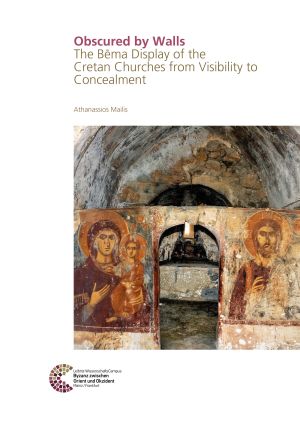Mailis, Athanassios
Obscured by Walls: The Bēma Display of the Cretan Churches from Visibility to Concealment
The book researches the Bēma display of the Cretan churches in a time period spanning from the Byzantine re-conquest of the island (11th century) until the middle of the Venetian dominance (15th century). It focuses on the apparition and distribution of the Templon-barrier, the function of a certain group of frescoes as prostration images and the (partial) establishment of fresco-painted masonry screens at the Orthodox churches of the island, just before the prevalence of the »wooden wall of icons« – known as Iconostasis.
This study reveals the artistic and cultic multiplicity of arrangements, consisting of archaism and modernization, until the crystallization of the Iconostasis as the »distinctive feature of churches of the Byzantine rite«, thus a material proof of cultural identity and religious consciousness of the Orthodox populace in an area (Crete) and a period (Venetian rule) that is characterized by both osmosis and conflict.
Preguntando se llega a Roma: Festschrift für Achim Arbeiter zum 65. Geburtstag
The volume contains fifteen essays by students and (former) colleagues of Achim Arbeiter, who celebrates his 65th birthday in 2023 and at the same time also his 25th anniversary as Professor of 'Christian Archaeology and Byzantine Art History' at the Georg-August-Universität Göttingen. The contributions deal with iconographic and iconological aspects of pictorial works, with stylistic, typological and iconographic aspects of architecture, with settlement archaeology, music, ancient traditions in Christian saint cults and the multiple occupation of graves. Chronologically, the studies range from Late Antiquity to the Middle Ages; geographically, they lead from the Levant via North Africa, the Balkans and Italy to the Iberian Peninsula.
Menschen, Bilder, Sprache, Dinge: Wege der Kommunikation zwischen Byzanz und dem Westen 1: Bilder und Dinge
In 2018, the Roman-Germanic Central Museum Mainz presents in cooperation with the Schallaburg, the splendid Renaissance castle near Melk (Lower Austria), the exhibition »Byzantium & the West: 1000 forgotten years «.
Both Byzantium and the European West spring from the Roman Empire, but as early as Late Antiquity experience different developments. While the Roman Empire continued to exist in the East and passed seamlessly into the Byzantine Empire of the Middle Ages, pagan polities took its place in the West: the kingdoms of the Goths, Vandals, Anglo-Saxons, Lombards and Franks. Although Byzantium was respected or accepted as a major power by the other European entities for at least 800 years, territorial conflicts, disputes, and cultural differences quickly emerged. In addition, communication became increasingly difficult - in the "orthodox" East, Greek was the common language, while in the "Catholic" West, Latin was the lingua franca. Differences in liturgy and questions of belief intensified the disparities or were even (religio-) politically underlined to emphasize dissimilarity. But one still continued to admire "wealthy Constantinople" and the Byzantine treasures - among them the magnificent silks, ivory reliefs, technical marvels, plentiful relics and magnificent buildings.
The change came in 1204 with the conquest and plunder of Constantinople by the Crusaders. For the already weakened Byzantine Empire, this catastrophe meant a completely new situation as an empire in exile, whose emperor and patriarch had to flee to Asia Minor. Across much of the former European Byzantine Empire, crusader states spread; Venice and Genoa, which had previously been strongly present as trade powers under special treaties, became major determinants of the western powers in the East.
On the occasion of this exhibition, two accompanying volumes with a total of 41 contributions concerning the varied and changing relationships between the Latin West and the Byzantine Empire are being published. The volumes are structured according to the media of communication: people, images, language and things. They collect contributions from renowned scientists with archaeological, art historical, philological and historical priorities. Several overviews and detailed studies are drawn from research projects of the Leibniz- ScienceCampus Mainz: Byzantium between Orient and Occident, as well as the focus on Byzantine and medieval research of the Austrian Academy of Sciences in Vienna.









